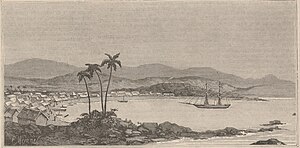First Madagascar expedition
| First Madagascar expedition (1883–85) |
|||||||
|---|---|---|---|---|---|---|---|
| Part of the Franco-Hova Wars | |||||||
 Tamatave, bombarded and occupied by the French under Admiral Pierre, on 11 June 1883. Le Monde Illustré, 1883. |
|||||||
|
|||||||
| Belligerents | |||||||
|
|
|
||||||
| Commanders and leaders | |||||||
|
|
|
||||||
| Strength | |||||||
| Cruisers Flore and Forfait Scout Vaudreuil Aviso Boursait Gunboat Pique Transporter aviso Nièvre |
|||||||
The First Madagascar expedition was the beginning of the Franco-Hova War and consisted of a French military expedition against the Merina Kingdom on the island of Madagascar in 1883. It was followed by the Second Madagascar expedition in 1895.
Following their capture of Mauritius from the French in 1810 during the Napoleonic Wars, with ownership confirmed by the 1814 Treaty of Paris, the British saw Madagascar as a natural expansion of their influence in the Indian Ocean. The Merina King, Radama I, managed to unite Madagascar under one rule, benefiting from British weapons and military instructors. He signed treaties with the British, allowing Protestant missionaries and outlawing the slave trade.
When Queen Ranavalona I took power in 1828, relationships with foreign powers gradually soured. By the mid-1830s, nearly all foreigners had chosen to leave or were expelled, and British influence was largely suppressed. An exception, the Frenchman Jean Laborde, was able to remain in the island to build foundries and an armament industry.
Meanwhile, the Queen's son Prince Rakoto (future King Radama II) had been under the influence of French nationals at Antananarivo. In 1854, a letter destined for Napoleon III that he dictated and signed was utilized by the French government as a basis for future invasion of Madagascar. He further signed the Lambert Charter on 28 June 1855, a document that granted Frenchman Joseph-François Lambert numerous lucrative economic privileges on the island, including exclusive right to all mining and forestry activities, and exploitation of unoccupied land, in exchange for a 10% fee to the Merina monarchy. A coup to topple the Queen and replace her by her son was also planned, in which Laborde and Lambert were involved. Upon the death of the queen, her son took over as King Radama II in 1861, but he only ruled two years before ending by an assassination attempt. This assassination was treated as successful at the time, although later evidence suggests Radama survived the attack and lived to old age as a regular citizen outside the capital. He was succeeded to the throne by his apparent widow Rasoherina.
...
Wikipedia
